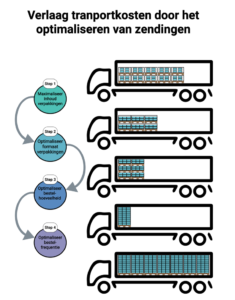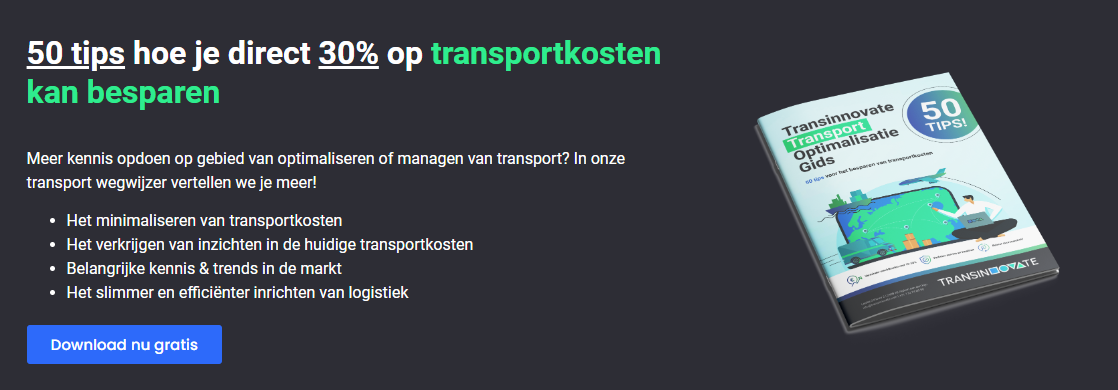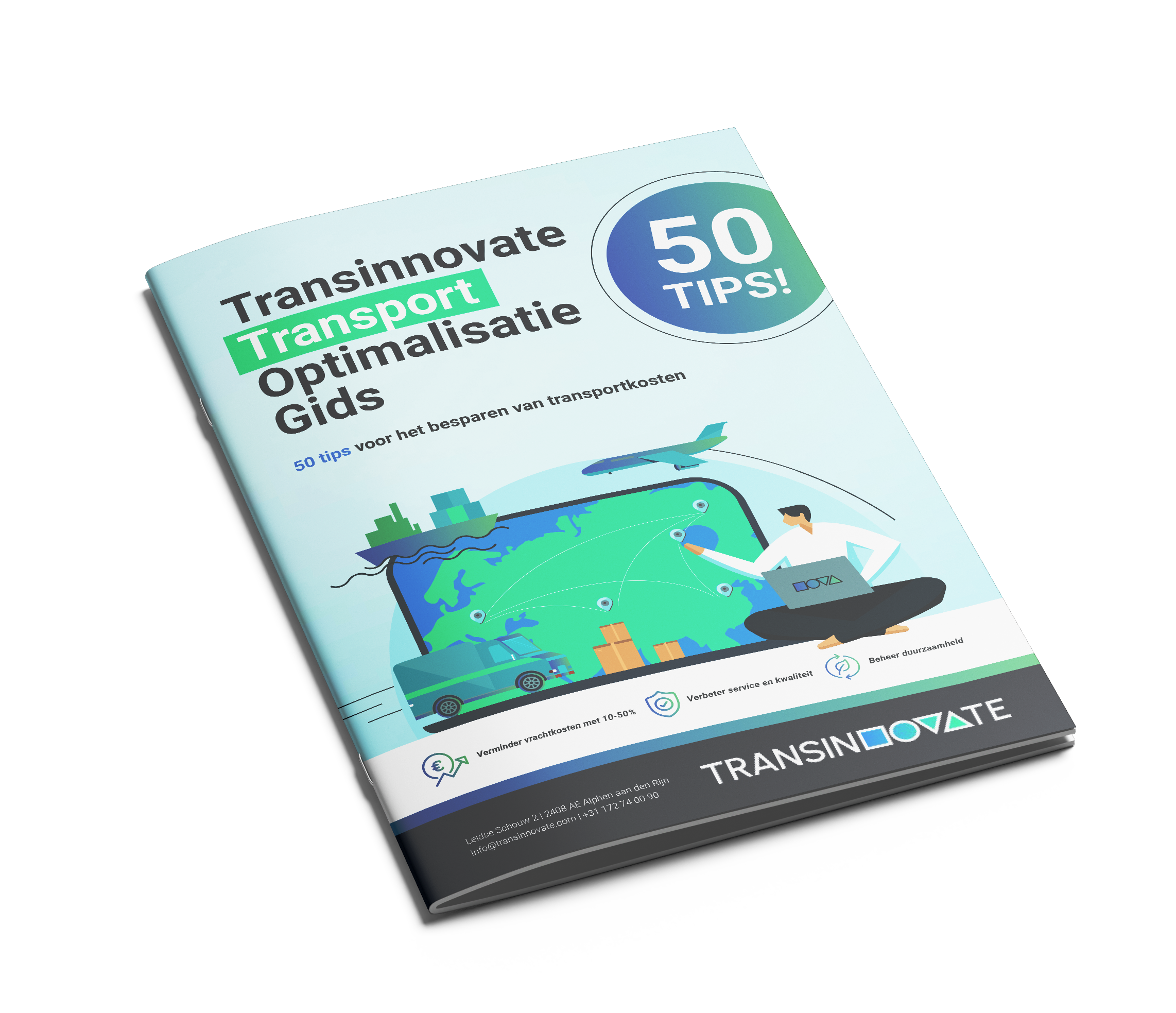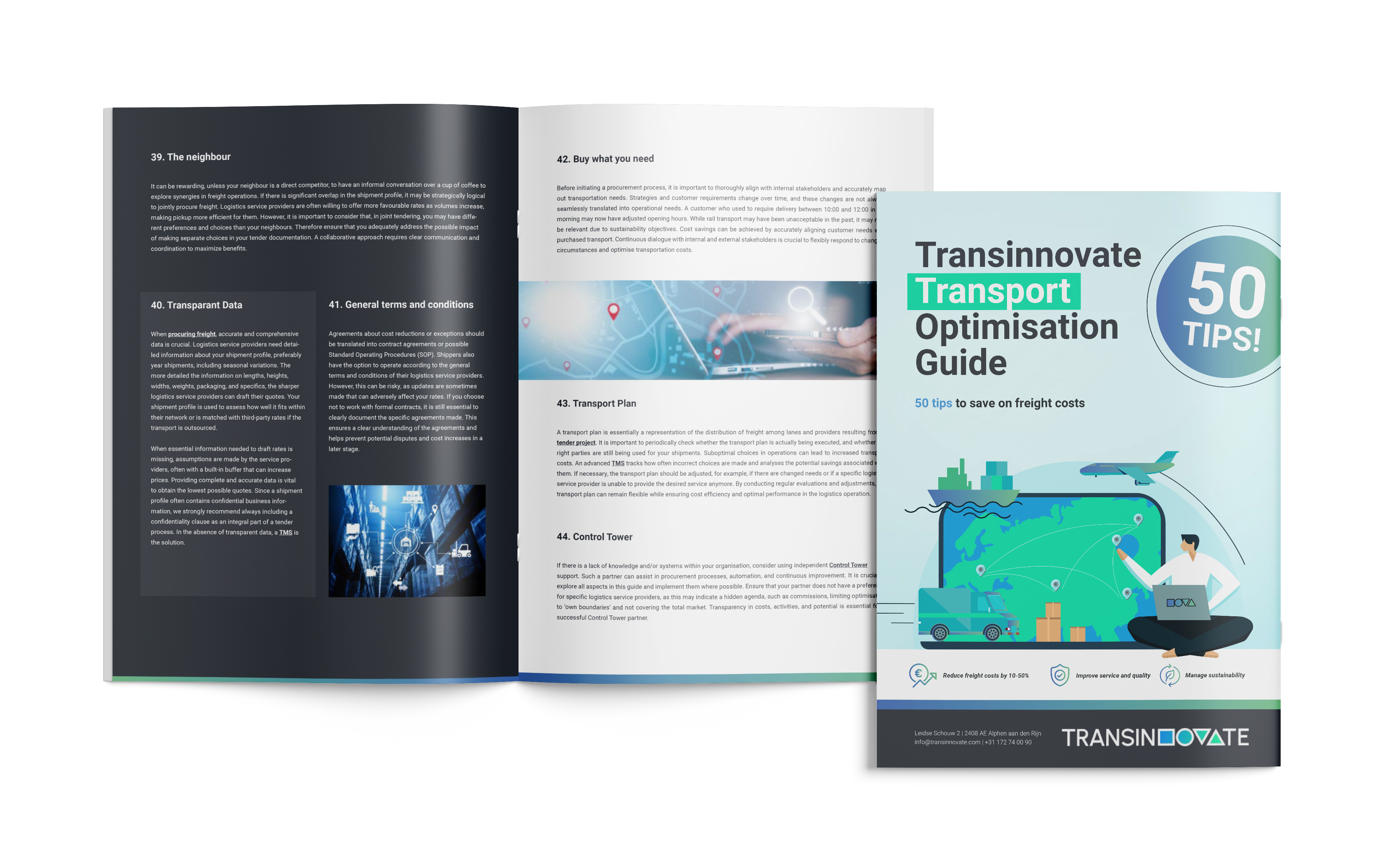We have listed 10 key tips to save on transport costs:
1. Make sure you buy cyclical transport
2. Put carriers in their power
3. Optimise pack sizes & pallet layout
4. Optimise order volumes
5. Optimise delivery frequencies
6. Analyse and reduce surcharges
7. Find the ideal ratio between contract rates and spot rates
8. Use a different modality, larger or different trailer
9. Automate the operational process with transport management software
10. Take Control and become your own Control Tower
Quick question?
Call or e-mail us directly. Our advisers are at your service immediately.
Tel: +31 172 74 00 90
E-mail: info@transinnovate.com
1. Make sure you buy cyclical transport
Perhaps a "buyer",but with effective procurement is obviously one of the most important aspects to save transportation costs. What is important in procurement is having sound knowledge of the (RFQ) process, of the market and having the right software tools available. If this is not the case, it might be better to decide to outsource the procurement process also called tender to an expert. Indeed, these 3 aspects are crucial to save many percent extra during a tender. Make sure you benchmark your rates properly periodically (advice: every 3 years). Want to know more about pitfalls during procurement or interested in tips during tendering? Take a look at our blogs, or to our tender service and get inspiration on the subject of transport procurement.
2. Put carriers in their power
A lot we see shippers failing to maximise the potential of carriers. What we mean by this is that shippers allocate carriers by country, for example, or for the wrong shipments. A country-level allocation may be easier to organise operationally, but in terms of service and transport costs it is often far from optimal. There are lots of specialists in the market, groupage, LTL, FTL, modality, country, region, etc. Finding the ideal combination and using it well will lead to lower transport costs and often even better service/quality. We once published a nice article written.
3. Optimise pack sizes & pallet layout
Transport is always charged based on load metres, volume and weight. For this reason, it is therefore wise to take a structural look at what and how exactly is being shipped. Try to avoid shipping "air" as much as possible. Sometimes simple actions can be taken in the warehouse to pack or stack more intelligently. But it is also sometimes wise to talk to product development before products are actually introduced. What seems interesting from a marketing point of view can sometimes be a very big cost for transport.
4. Optimise order volumes
Ensure that order volumes are matched to the shipping unit in which or with which they are shipped. We explain this with a simple example: a price per pallet has been agreed with a logistics provider, assuming the pallets are stacked full. 27 boxes of a particular product fit on a pallet. Then it makes sense to keep the order volume at 27 as well. After all, for 26 or fewer boxes, we pay the same cost as for 27 boxes, and for 28 or more boxes, we even pay double costs because an extra pallet has to be shipped. Look carefully at order volumes, packaging sizes and price agreements, there are bound to be opportunities to reduce transport costs.
5. Optimise delivery frequencies
Shippers will need to analyse their shipping profile regularly. For example, how often are shipments to the same address
within a certain time frame. Or perhaps there are  shipments better scheduled in a milk run.
shipments better scheduled in a milk run.
Combining shipments will not only reduce handling in the warehouse, but because of the rate tiers that service providers often use, it will also reduce transport costs. Sometimes it will be necessary to talk to the sales department to slightly educate customers or create some flexibility. Certainly if savings can be shared with customers, they will be more willing to adjust their ordering behaviour.
Use sustainability where appropriate to get customers over the threshold.
Save even more on transport costs? Request the free demo of our Transport Management Software!
- 24/7 support by transport experts
- All carriers at a glance
- Save costs & time immediately
- 90-day free trial
6. Analyse and reduce surcharges
There are two types of surcharges. Those that are charged because certain (service) choices are made when sending the transport order. Think of an urgent delivery, delivery at a certain time, delivery with a car with a valve, delivery on a floor, etc. There are also surcharges that are charged afterwards and unexpectedly. For example, because no one was available at the time of delivery and a second delivery has to be planned, waiting hours, faulty loads, problems with the goods, etc. Ensure insight into and control over all surcharges that are passed on. Ideally, record and approve them during the operational process, making invoice control easy. Analyse surcharges afterwards and consult with the relevant stakeholders to reduce them. If you do not have insight and grip on surcharges, read on at point 10.
7. Find the ideal ratio between contract rates and spot rates
Transport orders are forwarded either on the basis of contract rates (and price agreements) or on the basis of a spot rate obtained. Contract rates achieve certainty in terms of price fluctuations, but also in terms of required service and reliability. The cost of spot rates can sometimes be considerably lower, but availability is not guaranteed. After all, a good percentage of all trucks drive empty and service providers sometimes prefer to carry something rather than nothing. The key for companies is to find the ideal mix between contract and spot to suit their strategy. With our transport management software shippers can easily send transport orders from contracts or request spot rates when desired.
8. Use another modality, larger or different trailer
Investigate what possibilities there are to transport goods differently. Think of transport by train, barge (inland waterway), by sea, in containers instead of trucks or, for example, with larger trucks such as LHVs, mega or jumbo trailers. In all cases, besides cost savings, this will also have advantages in terms of sustainability of transport.
9. Automate the operational process with transport management software
Shippers often involve a lot of manual work in sending and updating transport orders, and managing surcharges. When this is still done via e-mails or in portals of logistics service providers, it often goes wrong. ERP systems themselves are often too limited to perform these operations properly. Besides the fact that managing the order flow and surcharges requires a lot of manual work and therefore valuable time, miscommunication on loading and unloading data sometimes occurs. The result can be that logistics service providers arrive at the door too early or late to load or unload, which can result in extra (error freight, urgency extra delivery) surcharges. Solve this easily by using a TMS. Automate the operational process, get a grip on orders by managing order statuses and reduce transport costs by preventing misunderstandings.
10. Take Control and become your own Control Tower
The subject of Control Tower is totally hip. We let a 3PL or 4PL specialist organise all our transport! We expect the provider of this to realise all the above 9 points, we expect full transparency in everything that is done, and this way we easily reduce our transport costs. It will be no secret, for such constructions Control Towers providers often charge huge amounts and transparent, it often is not.... A simple way to reduce transport costs is to act as a Control Tower yourself. What do you need, a TMS suitable for this purpose which allows shippers to easily analyse and optimise themselves. Still prefer to outsource the most complex aspects of optimisation, with us we call it: transport management services. Last but not least, make sure your Control Tower partner is fully transparent. Make sure upfront that your partner does not receive any commission from carriers. If your Control Tower partner has its own trucks, make clear arrangements. Make sure they do not use them suboptimally and thus for their own benefit.
To find out more about how we can help you reduce your transport costs, feel free to contact with us.




